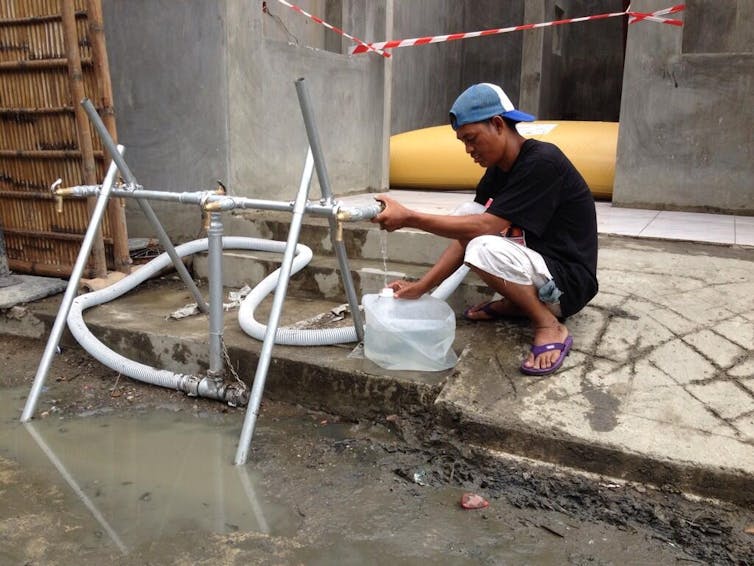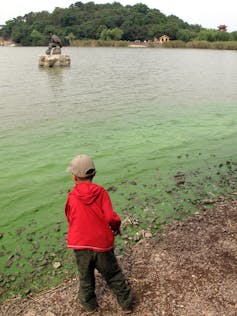Images of the typhoon-ravaged Philippines were terribly confronting, vividly conveying what an angry planet can dish up. But amid the destruction and death, an important point was largely missed: the world’s freshwater supplies are being degraded by a seemingly endless sequence of extreme events.
While infrastructures such as dams, sewerage plants, pumps and aqueduct/ stormwater systems can be destroyed by supercharged events, natural disasters can also strike a blow against water security. They can contaminate surface water with fecal matter (bacteria, viruses, protozoa, parasites and excreted drug products with a high level of persistence in the environment).
Toxic chemicals are released into soils and waterways from the flooding of polluted surfaces. Industrial containers are punctured, sewerage lines broken, latrines smashed, bodies decay and survivors defecate straight into the morass. Unpicking the pollutants from this witch’s brew becomes an engineering and economic nightmare.
Storm surge (it reached 3m in the Philippines) is yet another headache. And it doesn’t just affect poor countries: we saw it in the wealthy coastal communities of New York and New Jersey in the wake of Hurricane Sandy.
Apart from the physical damage to infrastructure, storm surge can leave surface and ground water adulterated by seawater. Stripping this mess of salt alone requires reverse osmosis treatment at incalculable carbon and financial cost. In most cases it doesn’t go ahead because the sheer scale of the remediation effort is prohibitive.

What should we do? Responses inevitably turn to preventative engineering solutions such as raised groundwater wells or disaster resilient reservoirs. But could a point be approaching where the sheer scale of catastrophes overwhelm even “hardened” buildings and infrastructures? (Whether such modifications could be afforded by developing rural communities is another question entirely.)
Certainly, renowned climate scientist James Hansen and his co-researchers think that we could well reach that point if we burn all our reserves of fossil fuels, observing that the resultant extreme weather would be totally beyond our capacities to adapt to.
These high impact events are being overlain on a situation where, according to one estimate, 1500km3 of global water is degrading every year.
The figures are rubbery, but we do know the number is growing at an exponential rate because of rising population and urbanisation in developing countries. As much as 90% of urban waste water in these places is being discharged to waterways and lakes insufficiently treated or directly untreated. This waste water constitutes a serious threat to human health, diversity of plants and animals, food security and the sustainability of water resources.

The gravity of the situation in developing countries is further highlighted by UNICEF and WHO’s World Sanitation Ladder.

Although a general improvement can be seen, these proportions are probably offset by ballooning population growth, especially in Southern Asia and South Eastern Asia where there’s still significant “open defecation” (straight to the ground). And that’s not to mention arsenic contamination of drinking water stemming from over exploitation of groundwater, particularly in Bangladesh.
Such trends in water pollution have caught the attention of businesses, with global energy and minerals forecasting firm Wood Mackenzie worried about “increased depletion of the resource over time, and growing concerns over contamination of dwindling water supplies”.
In fact, many streams are now largely effluent. India’s Yamuna River has no freshwater flow for almost nine months of the year: Delhi impounds water at a barrage constructed at Wazirabad, causing subsequent downstream flows to consist of sewage and other effluent. The oxygen-starved state of the river is evident from masses of rising sludge from the bottom, gas bubbles and floating solids on the surface.
The River Jordan is similarly blighted where extractions by Israel, Jordan (tributary) and Syria (tributary) have shrunk it to a meandering 100km stretch below Lake Kinneret that is mainly made up of effluent.

Then there’s China, where domestic sewage and nutrient leaching from farms have affected waterways and lakes. Recent data showed that nearly two-thirds of 40 freshwater lakes surveyed were eutrophic or de-oxygenated, including the iconic Taihu, Hongze and Caohu lakes.
In all these places an unfathomable cocktail of previous discharges is sequestered in soils, lake sediments and stream banks. Any measure of past prevention would clearly have been better than trying to clean this mess up now.
A more realistic objective is to reduce wastewater at the source while preventing toxic waste streams entering sensitive environments.
Excreted antibiotics and resistant bacteria (aka superbugs), widely found in effluent, can persist in water as resistant bacteria which people can acquire through the food chain. This suggests vast quantities of global wastewater identified by the UN will require exacting treatment if they are to have any hope of being safely reused.
In particular, the explosive use of cheap, generic antibiotics in Asia and India could see them leaving a devastating mark on the environment, possibly leading to a major health crisis.
And, coming full circle, the plague of natural disasters should encourage us to concentrate our minds on toughening up water infrastructures to limit future disruption.

